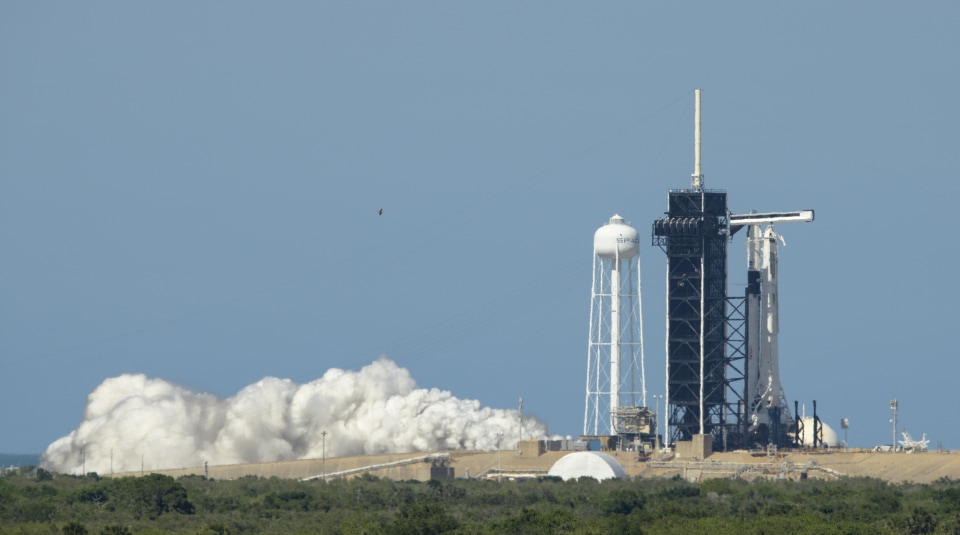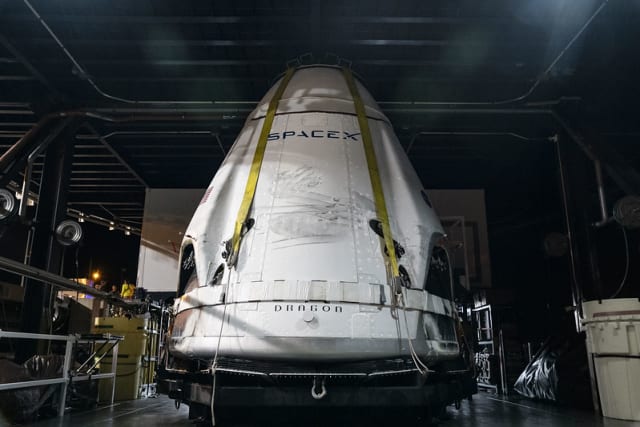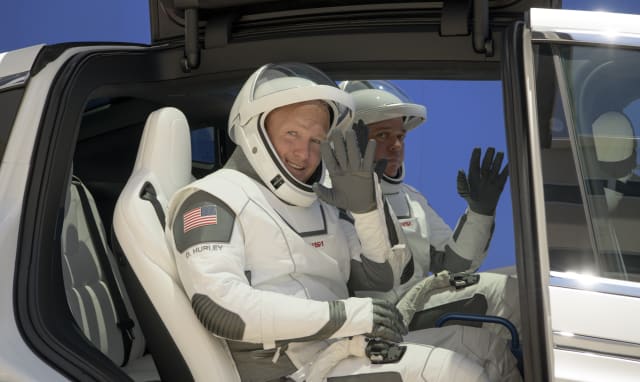
SpaceX's first crewed mission to the ISS is scrubbed for today
by Andrew TarantolaWe came this close to ushering in a new era of American spaceflight, one that combines the experience and capabilities of both private and public aerospace programs. But the weather simply wouldn’t cooperate. At roughly T-16 minutes, NASA scrubbed Wednesday’s SpaceX Falcon 9 launch that would have carried veteran astronauts Robert Behnken and Douglas Hurley on a 19-hour trip to the International Space Station. NASA has already identified May 30th and 31st as potential backup days to retry for lift-off. Stay tuned on Saturday for the second attempt which is happening at 3:22pm ET.
This would have been the first US-based launch since the shuttering of the space shuttle program, which dealt a savage blow to America’s space faring capabilities. Since the government decided against building a replacement crewed vehicle, NASA has had to rely on Russia’s Roscosmos to get its astronauts out to the International Space Station for nearly a decade -- at a price of up to $86 million per launch.
In recent years, a number of private aerospace firms have designed and tested crew capsules of their own including Blue Origin’s New Shepard, Virgin Galactic’s SpaceshipTwo, Boeing’s CST-100 Starliner, and SpaceX’s Crew Dragon. While the New Shepard and SpaceShipTwo are built for suborbital flights, NASA awarded Boeing and SpaceX multi-billion dollar contracts in 2014, as part of its newly-formed Commercial Crew Program, to shuttle astronauts to the ISS and back. SpaceX is expected to get $2.6 billion for six trips, while Boeing received $4.2 billion for a similar number of flights.

However, only SpaceX has so far managed to achieve flight certification from NASA. During an uncrewed test flight in December of 2019, Boeing’s spacecraft suffered a timing system malfunction which prevented it from reaching a high enough orbit to reach the ISS and returned to Earth after just two days, rather than the expected eight.
The Crew Dragon capsule is just the fifth crew transport vehicle ever deemed worthy by NASA, following the Gemini, Apollo, Mercury, and Space Shuttle. The Dragon capsule measures 13 feet in diameter and has seating for seven. It’s even got a toilet that Behnken and Hurley can use on their 19-hour journey to the ISS, though both SpaceX and NASA have remained mum on the details of where all those knobs and hoses go.

Behnken and Hurley are both accomplished test pilots and have been training for this mission since their selection in 2018. Once they do eventually get up on the ISS, NASA plans for them to remain aboard for anywhere from one to three months, up to 120 days, until another SpaceX mission ferries more astronauts up to relieve them. Their return trip is expected to be even more harrowing as the Crew Dragon will reenter the atmosphere above the Atlantic Ocean before deploying its parachutes for a water landing.
The Crew Dragon capsule isn’t the only new equipment SpaceX will be testing on this mission. The company has designed and fabricated a new generation of spacesuits to go along with it. Gone are the old-school Advanced Crew Escape System (ACES) suits (aka the “pumpkin suits”), replaced with a sleek design that was initially dreamt up by Hollywood costume designer Jose Fernandez. How this design was transformed into a functional spacesuit -- even the capabilities of the suits themselves -- remain closely guarded SpaceX secrets.
The COVID-19 outbreak has put a couple additional wrinkles in NASA’s preparations for this mission. "The health and welfare of the crew is always paramount," Courtney Beasley, communications specialist at NASA's Johnson Space Center, told CNN in March. "All of our crew must stay in quarantine for two weeks before they launch. This ensures that they aren't sick or incubating an illness when they get to the space station and is called 'health stabilization.'"
"During quarantine, the astronauts live in their crew quarters -- NASA has crew quarters for this purpose at Kennedy and Johnson Space Centers, and Roscosmos has them in Baikonur," she continued. "They don't have direct contact with anyone who has not been pre-cleared by NASA flight surgeons. The time is spent preparing for flight, studying and resting, as well as working out and making video calls to friends and family members."
NASA has implemented additional precautions for ground control as well. Facial coverings and physical distancing are mandatory, every new shift reports to a different control room so that the previous shift’s can be deeply cleaned. Civilian visitors were not allowed at Kennedy Space Center to view the launch and only a couple dozen reporters were invited to cover it in person.